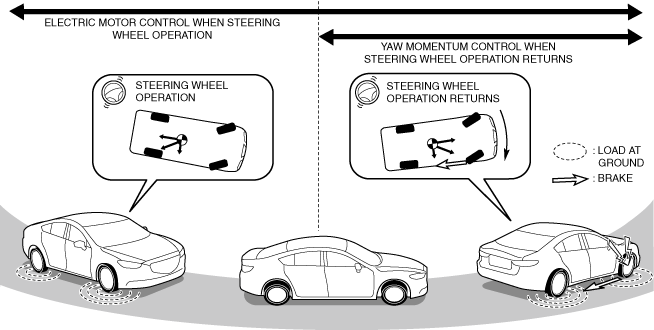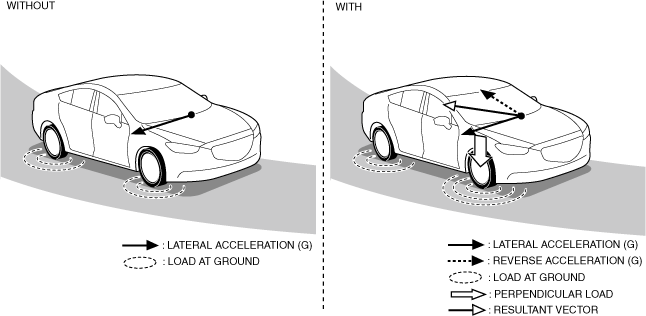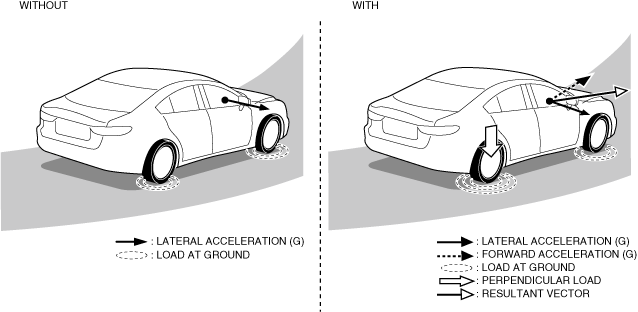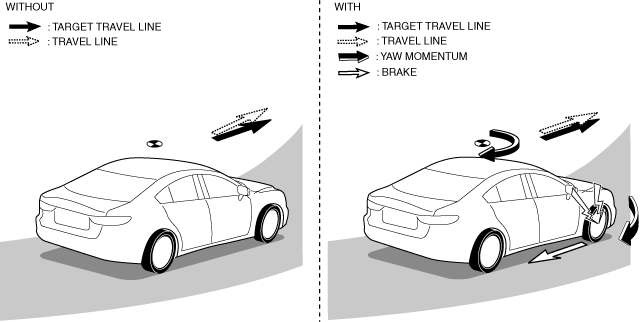ELECTRIC G-VECTORING CONTROL PLUS (e-GVC Plus)
id304000201300
Outline
• The electric G-vectoring control plus (e-GVC Plus) has an electric motor control during steering wheel operation, and a yaw momentum control during steering wheel return operation.
Electric motor control during steering wheel operation:
-
― The electric motor control during steering wheel operation is an electric motor control technology that enhances driving stability by optimizing the ground contact load on the tires according to the driving scenario. Smooth cornering and ride comfort are achieved by changing the electric motor torque and generating longitudinal acceleration speed at the optimum timing relative to the lateral acceleration speed based on the steering wheel operation.
Yaw momentum control during steering wheel return operation:
-
― The yaw momentum control during steering wheel return operation is a brake control technology that enhances driving stability by suppressing the vehicle oversteer behavior by the application of extremely small braking force to the turning, outer front wheel during steering wheel return operation. Steering stability is improved such as when making lane changes at high speeds or during emergency maneuvering, and when driving on slippery roads such as rain or snow-covered roads, achieving a high sense of driving safety.
Block Diagram
Function/Control
Electric motor control during steering wheel operation:
• The electric motor control during steering wheel operation performs comprehensive control of the longitudinal and lateral acceleration speeds (G) by changing the electric motor torque at an appropriate timing in conjunction with the steering wheel operation, and optimizes the load at the ground on the 4 wheels.
-
― When entering corner:
-
• Reverse acceleration speed (G) is applied to the vehicle by reducing the electric motor torque, and the load moves to the front wheels. Vehicle response is enhanced by applying the load to the front wheels.
Electric motor control when entering corner:
― When exiting from corner:
-
• Forward acceleration speed (G) is applied to the vehicle by increasing the electric motor torque, and the load moves to the rear wheels. Vehicle stability is enhanced with the load applied to the rear wheels.
Electric motor control when exiting from corner:
• The PCM operates the electric G-vectoring control plus (e-GVC Plus) electric motor control under the following conditions.
-
― While driving
― During steering operation
Electric motor control during steering wheel operation:
Yaw momentum control during steering wheel return operation:
• The yaw momentum control during steering wheel return operation enhances vehicle driving stability by applying the optimum brake force to the turning, outer front wheel in conjunction with the steering wheel operation.
-
― Yaw momentum control during steering wheel return operation:
-
• Yaw momentum is produced by applying the brake force to the turning, outer front wheel, and the vehicle approaches the target travel line. Vehicle stability is enhanced by approaching the target travel line.
Yaw momentum control during steering wheel return operation:
-
• Tire slipping, caused by a sudden steering wheel operation during emergency maneuvering can be prevented, enhancing vehicle stability.
• Because the vehicle inclination amount after emergency maneuvering is small and the operation for returning the steering wheel is small, the driver can drive with a sense of safety and leeway.
Yaw momentum control during steering wheel return operation:






